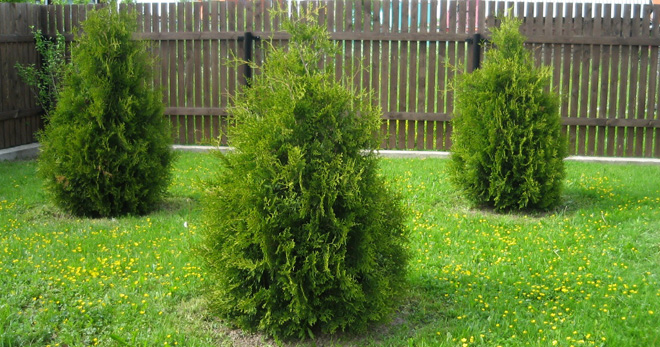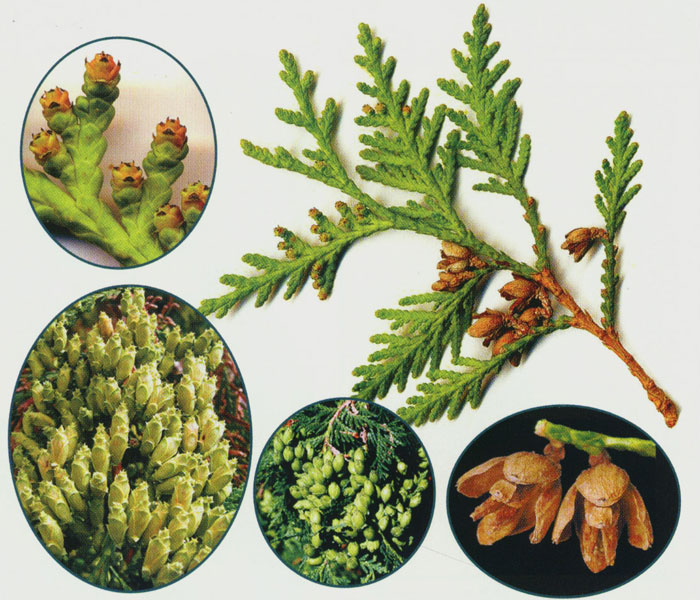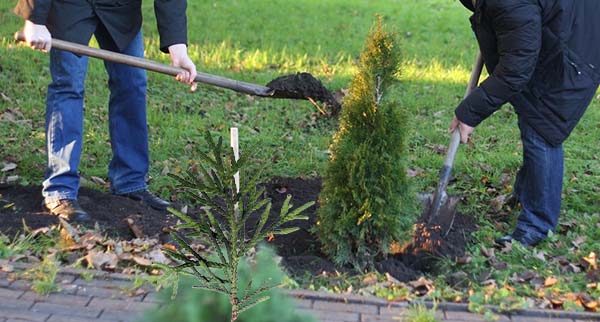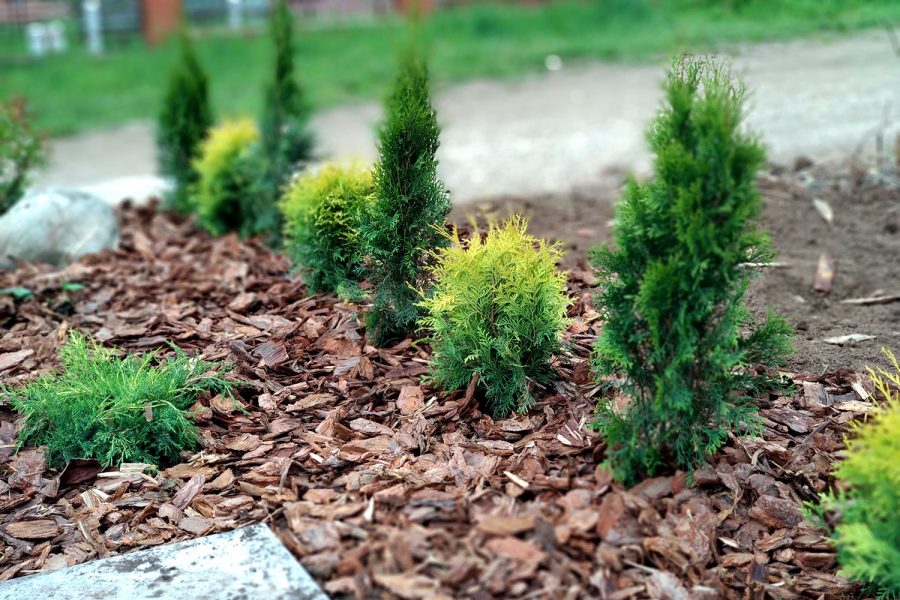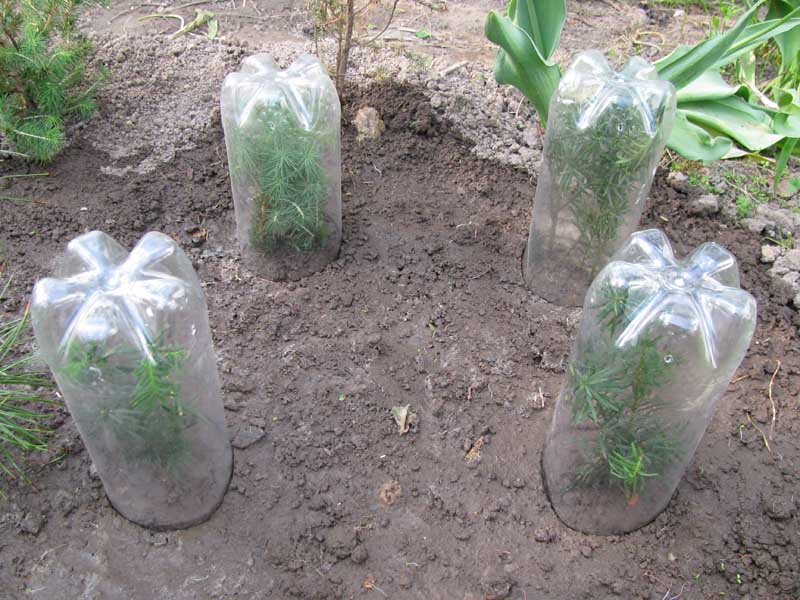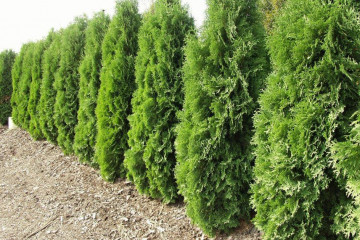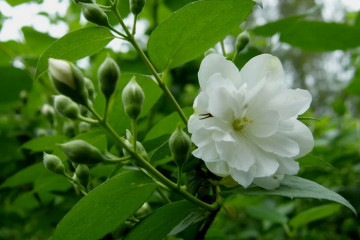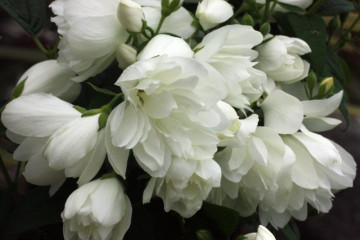Thuja smaragd - description and size, planting and care
Content:
Thuja translated from Latin means "tree of life". It is also often called the paradise tree, because in mythology there are many stories that say: thuja connects heaven and the underworld. It is also believed to grow in the middle of paradise. Its homeland is Asia and North America.
Thuja smaragd western
Thuja smaragd belongs to the Cypress family. An evergreen plant can delight the eye for 50 to 100 years. The monoecious tree has a narrow and dense pyramidal shape.
Thuja smaragd: description and dimensions
Thuja western smaragd is distinguished by its unique description:
- the tree grows in size from 4 to 6 m in height and up to 2 m in width. The difference in growth depends on the variety. In the wild, the height can reach 70 m;
- it has a dense crown, which is covered with needles. Designers love to create real sculptural masterpieces from it, which becomes an adornment of any landscape;
- in spring, small brown cones appear on the tree, which fall off with the onset of cold autumn;
- in Russia there are two types - a tree with a green and a golden color;
- it gives off a kind of pleasant resinous aroma.
How fast does thuja smaragd grow
Thuja western grows very slowly. Over the year, she adds 10 cm in height and 5 cm in width.
Planting and leaving
To grow a strong and healthy tree, you need to think carefully about all the details. Half of the success depends on the correct planting site. Thuja smaragd loves sunlight, however, it is not worth allowing the plant to be in the sun all day, since the rays will lead the tree to dehydration, and the blue thuja will not tolerate the winter well.
Although the tree can grow comfortably in swamps and clay, it is still better to plant it in nutritious soil. To do this, you need to mix peat, turf soil and sand.
Thuja is planted from seeds and cuttings. Growing from seed is a difficult and time-consuming process. From the period of sowing the planting material to transplanting it into the soil, it can take from 2 to 5 years.
The cones are harvested in the year the tree bears fruit. They are placed in a warm place where they open and the seeds spill out. Only large specimens are selected for sowing.
The advantage of growing a coniferous specimen from seeds is that it will form strong and will be fully adapted to the climate of the region.
In order for the process of growing thuja from seeds to be successful, you need to adhere to certain rules:
- the fruits are sown in wet sand and cover the pot with a film;
- the future crop is placed in a refrigerator or a cool place for 2 or 3 months with a temperature of about 6 ° C;
- sowing must be monitored, periodically remove the film and ventilate so that condensation does not accumulate;
- in February, the plant is transplanted into soil made from turf, peat and sand. For the purpose of disinfection, the soil is watered with a solution of potassium permanganate. Plants are placed in a room with a temperature of 20 ° C;
- when the sprouts grow up, they are moved to a cool place and provided with good lighting;
- you need to apply mineral fertilizers to the soil 2 times a month;
- when the seedlings are 2 years old, they dive. In summer, pots with plants are taken out into fresh air and placed in partial shade;
- in the third year, the seedlings are planted in larger containers. When they reach a height of 50 cm, they are planted from the nursery to the street in their permanent habitat. This happens no later than five years after planting the seeds.
Gardeners also practice outside planting. Collected in the fall, it is better to plant them in boxes, since the young plant looks like dill and is easily confused with weeds. The branches of the tree appear when it is 6 months old.
How to plant thuja emerald
More than one gardener is wondering how to plant thuja emeralds and how much space they need.
Step-by-step landing instructions:
- You need to dig a hole with a diameter of about a meter and a depth of no more than 80 cm.
- Line the bottom with a drainage layer, then pour soil mixed with 2 tbsp into the hole. ash and mineral fertilizers.
- The seedling is placed so that the root collar is above the surface.
- If there is a desire to form a hedge from a thuja, then the plants are planted at a distance of no more than one meter from each other. For free growth, you need 2-5 m between trees. Such living fences will give odds to any creeping bushes, which are also made by hedges.
Watering mode
The regularity of watering depends on the rainfall. On hot days, the tree is watered every 3 days. You need to use at least 10 liters of water per plant. Watering is carried out in the morning or in the evening. Also, the tree needs to be sprayed regularly.
Top dressing
For thuja, as for other conifers, it is very important to ensure proper feeding. However, it is worth remembering that you should not overuse fertilizers. An overabundance of minerals can negatively affect the development of the tree.
Top dressing must be applied both during planting and throughout the entire period of active growth of decorative thuja. Although an adult tree has a well-developed root system and is able to independently extract nutrients from the soil, it also needs feeding.
Fertilization is divided into several stages:
- When planting, ash and compost are added to the soil. One hole accounts for 3 kg of ash, which is sprinkled on the bottom, and a bucket of compost is mixed with the soil. After that, no fertilizer is applied for a whole year.
- The next feeding is carried out in the spring. Mineral substances are introduced into the soil, which contain: nitrogen, phosphorus, potassium, calcium, iron and other useful substances. This happens at the beginning or at the end of March, it all depends on the weather conditions. If the thuja did not endure the winter well, then you need to help her get stronger. For this, root is suitable.
- It is important to feed the plants at the end of summer. During this period, humus is used, which not only nourishes the plants, but also protects them from fungus.
Experienced summer residents identify several golden rules for fertilizing:
- you cannot add different dressings that have almost the same composition. Overdose may occur;
- between fertilization of the soil should pass at least 2 weeks;
- the day before fertilizing, the soil must be watered;
- in the fall, all feeding is stopped.
Features of summer care
On hot summer days, the thuja should be protected from the scorching rays. For this, a small structure above the tree is suitable.
Periodically, you need to remove weeds and eliminate insect nests. Loosening the soil regularly will provide good air circulation to oxygenate the roots.
It is useful to mulch the soil once a year. This will protect the area from weeds and retain moisture.
Preparing for winter
Young seedlings of the first year of life must be covered. Mature trees can survive the winter outdoors. A frame is built around the seedlings and covered with a non-woven white material. This design will allow the snow to slide off the top, and not linger on the branches of the trees.
You also need to take care of the root system, otherwise the tree will dry out. To do this, the leaves are mixed with earth and sprinkled over the area. This mixture will help retain moisture in the soil, and rotted leaves will also serve as fertilizer.
Preparation for winter is carried out in the fall before the snow falls.
With the onset of spring, do not rush to open the tree. It can be damaged by sunlight. You should wait until the earth dries out, and the outside temperature will be above zero.
Reproduction
Reproduction of thuja at home occurs with the help of seeds, twigs and cuttings. Sowing seeds has already been mentioned above, and now we will talk about less painstaking methods of reproduction, which include twigs and cuttings.
In order for the branches to start, the cut site is treated with growth stimulants and placed in a box. Several branches can be planted in one pot, the main thing is to maintain a distance of 3-5 cm between them.
In spring, mature plants can be placed in a greenhouse, and in summer they are already planted in their permanent habitat.
Propagation by cuttings
The propagation method by cuttings is the simplest. This process takes place in the fall. Strong and healthy shoots are used in the role of planting material. The cuttings should not be too young or too old. It is necessary to pick up shoots from the middle of the trunk.
The shoots are planted in prepared soil, which is a mixture of peat and leafy soil. They are taken in equal amounts.
During the reproduction process, the following recommendations should be adhered to:
- extra leaves must be eliminated, and those that remain must not touch the peat;
- you need to install a greenhouse for the cutting, a transparent glass jar is suitable for this;
- seedlings are placed in a warm place. The air humidity should not exceed 70%, and the temperature should reach about 23 ° C, otherwise the sprout may rot;
- ideally, it will not be watering at the root, but regularly sprayed.
If new shoots appear on the thuja, it means that it has successfully rooted. However, you should not rush to plant a tree in the soil. First, the greenhouse must be ventilated, gradually accustoming the cuttings to fresh air.
Thuja needles turn yellow: what to do
Many gardeners are wondering why thuja turns yellow. This happens for many reasons. The main ones include:
- natural processes. The foliage of the needles dies off after 3-5 years, therefore it turns yellow and dries up;
- seasonal changes. Some varieties of thuja acquire a golden-bronze color in winter;
- improperly selected soil. If the thuja is planted in sandy soil, then it will lack moisture, which quickly goes into the ground, and the seedling will turn yellow. There are not enough nutrients for the germination in the clay soil, but water can stagnate in the peat, and the tree will rot;
- care errors: insufficient watering, thickened planting, poor lighting, lack of phosphorus, nitrogen and iron, low air temperature;
- the presence of pests: scale insects, miner moths, leafworms, spider mites, etc. These parasites do not mind taking advantage of the leafy part of the thuja. Insecticides should be used in the fight;
- tree diseases, the same as in juniper: brown shute, late blight. Herbicides will help in the treatment.
What to do when thuja turns yellow?
What are the thuja
The most common in Russia are the following varieties of tui: western, folded and geometric.
Thuja species
On summer cottages and in city alleys, the following types of thuja are most often found:
- western. In nature, it grows up to 20 cm. The tree has a cone-shaped crown narrowed to the top, which eventually becomes round. The brown bark peels off a little and hangs down. Plant cones 1.5 cm long ripen by autumn and quickly crumble;
- eastern. This name stuck to the tree, which is actually not a thuja. It would be more correct to call it the eastern biota. The plant develops very slowly. In cold climates, it becomes like a shrub;
- giant thuja native to North America. In nature, its height reaches 60 m. In St. Petersburg, there are specimens about 15 m high. However, due to the harsh climate, they often freeze slightly;
- Japanese. Its homeland is Japan. In their culture, this plant is considered one of the five sacred Kiso trees. He was even banned from cutting down. In nature, the height of this species reaches 35 m;
- Korean thuja is a shrub or tree with a loose crown. She lives in Korea and China. The needles have a strong odor and have a bluish-silver color.
All varieties of western thuja in the table:
| Variety name | Needle color | disadvantages | Benefits |
| Emerald | Emerald green | Growing slowly. | Resistant to unstable climatic conditions. |
| Brabant | Green, and young representatives have golden tips. | Needs frequent pruning (2 times per season). | Fast growth (about 40 cm per year), which is the main difference of this variety. |
| Danica | Green | It grows very slowly. | It is a unique ornamental spherical plant. |
| Golden Glod | Green needles with light green tips. | Has a loose crown of needles. | It has a beautiful spherical shape, therefore it serves as an excellent decoration for any design. |
| Columna | Dark green. | Growing slowly. | It is a cheap option for a tall hedge. |
| Teddy | Green in spring and summer and bronze in winter. | Very slow growth. | Reacts well to haircuts. |
| Holmstrup | Dark green | Growing slowly. | Drought tolerant. Maintains its shape without cropping. |
| Yellow Ribbon | In juveniles it is orange-yellow, in adults it is green, and in winter it is brown. | With a lack of sunlight, it will lose its bright color. | Ideal for hedges. |
| Miriam | Golden yellow and orange in winter. | Loses its rich color in the shade. | Attractive spherical shape and bright color. |
| Woodwardy | Intense green color. | Dims in the shade. | With the return, the branches diverge more to the sides. |
| Little Giant | Bright green needles, and bronze-green in winter. | Needs loamy soil. | Possesses a luxurious dense crown. |
| Fastigiata | Green. | Prefers loamy soil. | Possesses soft needles. |
You can make a hedge or beautiful sculptural structures from it. In any case, with the help of a pruner, you can give freedom of imagination and turn a summer cottage into a real fairy tale.
